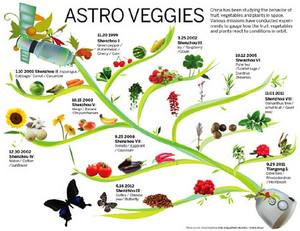China intensifies sowing seeds in space
During the past 25 years, Chinese scientists have constantly put more seeds into space, and have bred over 120 types of plants.

The plants that have been successfully propagated by China in space (Photo: Chinadaily)
In particular, outstanding agricultural crops such as eggplant, cucumber, pepper, chili and tomato.
Scientists bred to mutant eggplant are as big as a half-meter long basketball and cucumber. For fruits that come from seeds put on space, they often have a higher price than normal.
According to Mr. Li Qingsheng, director of a seed company in western China, said in Gansu province, chili Hangjiao-5 propagated from space accounted for more than half of the chili market share in the local market. This type of chili is also sold at a higher price. At the same time, farmers also want to grow this kind of chili because it grows fast, has high yield and consumers also prefer this chili because of the thick meat and less seeds.
The chili planting area, using seeds developed from seeds brought into space by the Shenzhou III ship in 2002, has spread to other provinces and regions, including the Xinjiang autonomous region, Yunnan. and Thanh Hai province.
Besides, with the help of space technology, many varieties of eggplant, tomato, bean . have also entered the market.
Only a few days in space but the seeds above may have the characteristics that scientists want. But many years ago, breeders had to do a lot to prepare for the birth of this new seed.
For the first time, China introduced plant varieties into space with a satellite in 1987. When Russia's space station Mir was active in 1992-1998, China introduced a small and large tomato plant to Mir station. sow. But some seeds did not germinate. By 2005, new varieties of tomatoes were successfully seeded by Chinese scientists by selecting seeds with good characteristics. Each time choosing a generation of particles, it usually takes 4 years, though it is still faster than traditional breeding.
Before China, Russia used spatial mutations to improve crops, including wheat, cotton and Christmas trees. The US also uses this method to improve rose oil to help make perfume. Although these countries have cut a portion of the technology so far, China is still increasing the seed sown in space.
China is still trying to discover mysterious high-energy radiation particles in space that can cause mutations in plants, or use it as an alternative to unused hazardous chemicals. on the ground, like the Cobalt-60 case.
There are currently at least 224 research groups at scientific research institutes in China and at least 60 seed-growing plants in space have been established in China. So far, China has brought nearly 400 seeds of seeds into space in 23 launches and 10 spacecraft launches in its manned space program.
It is expected that when China's space station is assembled in 2020, it will provide an important basis for Chinese scientists to conduct experiments and explore the secrets of space-based mutations.
- Sowing human DNA on other planets
- Discover self-seeding plants in Brazil
- Grafting tomatoes on eggplant root
- China aspires to create genetically modified seeds in outer space
- How to choose melon seeds is not stained with chemicals
- Detecting exotic seeds located 2,000 years in the tomb
- The fruits with seeds are eaten by no one to notice
- Survivability of seeds in the universe
- Pumpkin seeds cure many diseases
- China speeds up space
- Excellent use of chia seeds for health
- Complete the rice sowing process in line
 Van Allen's belt and evidence that the Apollo 11 mission to the Moon was myth
Van Allen's belt and evidence that the Apollo 11 mission to the Moon was myth The levels of civilization in the universe (Kardashev scale)
The levels of civilization in the universe (Kardashev scale) Today Mars, the sun and the Earth are aligned
Today Mars, the sun and the Earth are aligned The Amazon owner announced a secret plan to build a space base for thousands of people
The Amazon owner announced a secret plan to build a space base for thousands of people